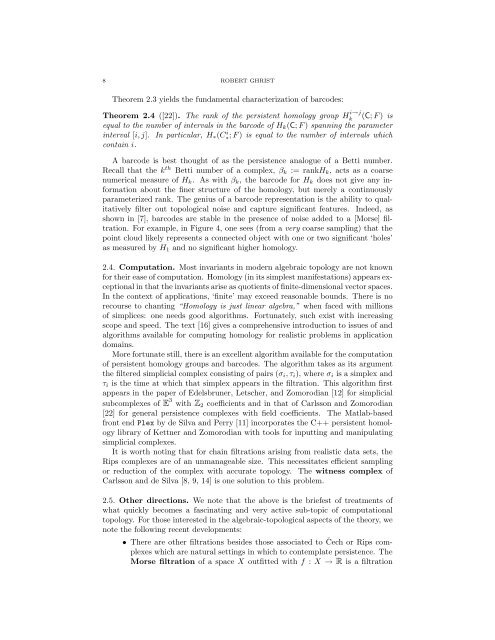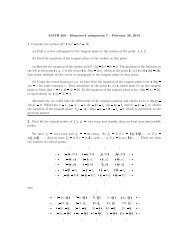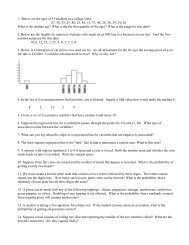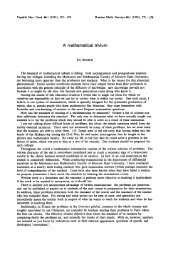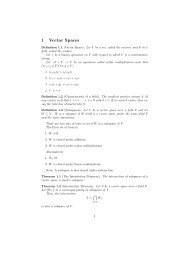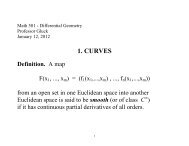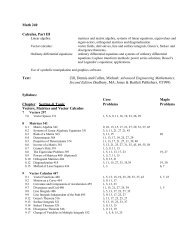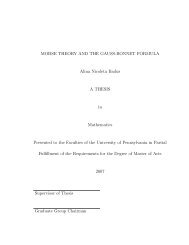Barcodes - Department of Mathematics
Barcodes - Department of Mathematics
Barcodes - Department of Mathematics
You also want an ePaper? Increase the reach of your titles
YUMPU automatically turns print PDFs into web optimized ePapers that Google loves.
8 ROBERT GHRIST<br />
Theorem 2.3 yields the fundamental characterization <strong>of</strong> barcodes:<br />
Theorem 2.4 ([22]). The rank <strong>of</strong> the persistent homology group H i→j<br />
k (C; F) is<br />
equal to the number <strong>of</strong> intervals in the barcode <strong>of</strong> Hk(C; F) spanning the parameter<br />
interval [i, j]. In particular, H∗(Ci ∗ ; F) is equal to the number <strong>of</strong> intervals which<br />
contain i.<br />
A barcode is best thought <strong>of</strong> as the persistence analogue <strong>of</strong> a Betti number.<br />
Recall that the k th Betti number <strong>of</strong> a complex, βk := rankHk, acts as a coarse<br />
numerical measure <strong>of</strong> Hk. As with βk, the barcode for Hk does not give any information<br />
about the finer structure <strong>of</strong> the homology, but merely a continuously<br />
parameterized rank. The genius <strong>of</strong> a barcode representation is the ability to qualitatively<br />
filter out topological noise and capture significant features. Indeed, as<br />
shown in [7], barcodes are stable in the presence <strong>of</strong> noise added to a [Morse] filtration.<br />
For example, in Figure 4, one sees (from a very coarse sampling) that the<br />
point cloud likely represents a connected object with one or two significant ‘holes’<br />
as measured by H1 and no significant higher homology.<br />
2.4. Computation. Most invariants in modern algebraic topology are not known<br />
for their ease <strong>of</strong> computation. Homology (in its simplest manifestations) appears exceptional<br />
in that the invariants arise as quotients <strong>of</strong> finite-dimensional vector spaces.<br />
In the context <strong>of</strong> applications, ‘finite’ may exceed reasonable bounds. There is no<br />
recourse to chanting “Homology is just linear algebra,” when faced with millions<br />
<strong>of</strong> simplices: one needs good algorithms. Fortunately, such exist with increasing<br />
scope and speed. The text [16] gives a comprehensive introduction to issues <strong>of</strong> and<br />
algorithms available for computing homology for realistic problems in application<br />
domains.<br />
More fortunate still, there is an excellent algorithm available for the computation<br />
<strong>of</strong> persistent homology groups and barcodes. The algorithm takes as its argument<br />
the filtered simplicial complex consisting <strong>of</strong> pairs (σi, τi), where σi is a simplex and<br />
τi is the time at which that simplex appears in the filtration. This algorithm first<br />
appears in the paper <strong>of</strong> Edelsbruner, Letscher, and Zomorodian [12] for simplicial<br />
subcomplexes <strong>of</strong> E 3 with Z2 coefficients and in that <strong>of</strong> Carlsson and Zomorodian<br />
[22] for general persistence complexes with field coefficients. The Matlab-based<br />
front end Plex by de Silva and Perry [11] incorporates the C++ persistent homology<br />
library <strong>of</strong> Kettner and Zomorodian with tools for inputting and manipulating<br />
simplicial complexes.<br />
It is worth noting that for chain filtrations arising from realistic data sets, the<br />
Rips complexes are <strong>of</strong> an unmanageable size. This necessitates efficient sampling<br />
or reduction <strong>of</strong> the complex with accurate topology. The witness complex <strong>of</strong><br />
Carlsson and de Silva [8, 9, 14] is one solution to this problem.<br />
2.5. Other directions. We note that the above is the briefest <strong>of</strong> treatments <strong>of</strong><br />
what quickly becomes a fascinating and very active sub-topic <strong>of</strong> computational<br />
topology. For those interested in the algebraic-topological aspects <strong>of</strong> the theory, we<br />
note the following recent developments:<br />
• There are other filtrations besides those associated to Čech or Rips complexes<br />
which are natural settings in which to contemplate persistence. The<br />
Morse filtration <strong>of</strong> a space X outfitted with f : X → R is a filtration


